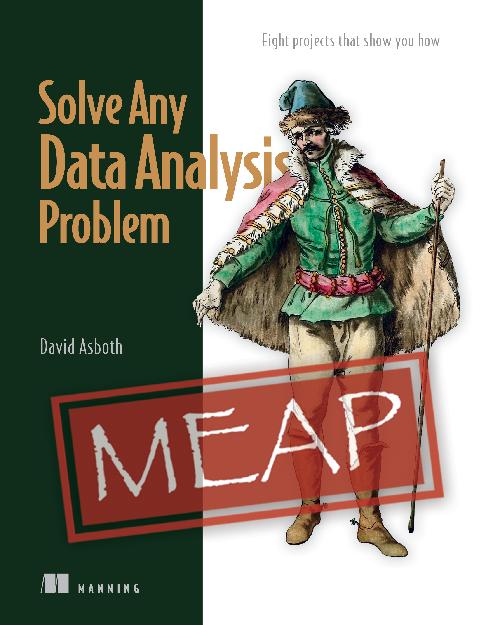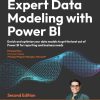Solve Any Data Analysis Problem MEAP V02 1st Edition by David Asboth ISBN 9781633437531
$50.00 Original price was: $50.00.$25.00Current price is: $25.00.
Solve Any Data Analysis Problem MEAP V02 1st Edition by David Asboth – Ebook PDF Instant Download/Delivery: 9781633437531
Full download Solve Any Data Analysis Problem MEAP V02 1st Edition after payment

Product details:
ISBN 13: 9781633437531
Author: David Asboth
Solve Any Data Analysis Problem MEAP V02 1st Edition Table of contents:
1 Bridging the gap between data science training and the real world
1.1 The data analyst’s toolkit
1.2 A results-driven approach
1.2.1 Understand the problem
1.2.2 Start at the end
1.2.3 Identify additional resources
1.2.4 Obtain the data
1.2.5 Do the work
1.2.6 Present the minimum viable answer
1.2.7 Iterate if necessary
1.3 Project structure
Summary
2 Encoding geographies
2.1 Project 1: Identifying customer geographies
2.1.1 Data dictionary
2.2 An example solution: Finding London
2.2.1 Setting ourselves up for success
2.2.2 Creating the first iteration of a solution
2.2.3 Review and future steps
2.3 How to use the rest of the book
Summary
3 Data modeling
3.1 The importance of data modeling
3.1.1 Common data modeling tasks
3.2 Project 2: Who are your customers?
3.2.1 Problem statement
3.2.2 Data dictionary
3.2.3 Desired outcomes
3.2.4 Required tools
3.3 Planning our approach to customer data modeling
3.3.1 Applying the results-driven process to data modeling
3.3.2 Questions to consider
3.4 An example solution: Identifying customers from transactional data
3.4.1 Developing an action plan
3.4.2 Exploring, extracting, and combining multiple sources of data
3.4.3 Applying entity resolution to deduplicate records
3.4.4 Conclusions and recommendations
3.5 Closing thoughts on data modeling
3.5.1 Data modeling skills for any project
Summary
4 Metrics
4.1 The importance of well-defined metrics
4.2 Project 3: Defining precise metrics for better decision making
4.2.1 Problem statement
4.2.2 Data dictionary
4.2.3 Desired outcomes
4.2.4 Required tools
4.3 Applying the results-driven method to different metric definitions
4.3.1 Questions to consider
4.4 An example solution: Finding the best performing products
4.4.1 Combining and exploring product data
4.4.2 Calculating product-level metrics
4.4.3 Finding the best products using our defined metrics
4.5 Closing thoughts on metrics
4.5.1 Skills for defining better metrics for any project
Summary
5 Unusual data sources
5.1 Identifying novel data sources
5.1.1 Considerations for using new datasets
5.2 Project 4: Analyzing film industry trends using PDF data
5.2.1 Problem statement
5.2.2 Data dictionary
5.2.3 Desired outcomes
5.2.4 Required tools
5.3 Applying the results-driven method to extracting data from PDFs
5.4 An example solution: Effects of the COVID-19 lockdown periods on the film industry
5.4.1 Inspecting the available data
5.4.2 Extracting data from PDFs
5.4.3 Analyzing the data extracted from PDFs
5.4.4 Project conclusions and recommendations
5.5 Closing thoughts on exploring novel data sources
5.5.1 Skills for exploring unusual data sources for any project
Summary
6 Categorical data
6.1 Working with categorical data
6.1.1 Methods for handling categorical data
6.1.2 Working with survey data
6.2 Project 5: Analyzing a survey to understand developer attitudes toward AI tools
6.2.1 Problem statement
6.2.2 Data dictionary
6.2.3 Desired outcomes
6.2.4 Required tools
6.3 Applying the results-driven method to analyzing the developer survey
6.4 An example solution: How do developers use AI?
6.4.1 Exploring categorical data
6.4.2 Analyzing categorical survey data
6.4.3 Project progress so far
Summary
7 Categorical data: Advanced methods
7.1 Project 5 revisited: Analyzing survey data to determine developer attitudes to AI tools
7.1.1 Data dictionary
7.1.2 Desired outcomes
7.1.3 Summary of the project so far
7.2 Using advanced methods to answer further questions about categorical data
7.2.1 Binning continuous values to discrete categories
7.2.2 Using statistical tests for categorical data
7.2.3 Answering a new question from start to finish
7.2.4 Project results
7.3 Closing thoughts on categorical data
7.3.1 Skills for working with categorical data for any project
Summary
8 Time series data: Data preparation
8.1 Working with time series data
8.1.1 The hidden depth of time series data
8.1.2 How to work with time series data
8.2 Project 6: Analyzing time series to improve cycling infrastructure
8.2.1 Problem statement
8.2.2 Data dictionary
8.2.3 Desired outcomes
8.2.4 Required tools
8.3 Applying the results-driven method to analyzing road traffic data
8.4 An example solution: Where should cycling infrastructure improvements be focused?
8.4.1 Investigating available data and extracting time series
8.4.2 Project progress so far
Summary
9 Time series data: Analysis
9.1 Project 6 revisited: Analyzing time series to improve cycling infrastructure
9.1.1 Problem statement
9.1.2 Data dictionary
9.1.3 Desired outcomes
9.2 Where should cycling infrastructure improvements be focused?
9.2.1 Analysis of time series data
9.2.2 Project conclusions and recommendations
9.3 Closing thoughts: Time series
9.3.1 Skills for working with time series data for any project
Summary
10 Rapid prototyping: Data analysis
10.1 The rapid prototyping process
10.1.1 Rapid prototyping example
10.2 Project 7: Build a proof of concept to investigate Welsh property prices
10.2.1 Problem statement
10.2.2 Data dictionary
10.2.3 Desired outcomes
10.2.4 Required tools
10.3 Applying the results-driven method to investigating Welsh property data
10.4 An example solution: Building a prototype to explore using house price data
10.4.1 Analyzing data before prototyping
10.4.2 Investigating geographic aspects of a dataset
10.4.3 Identifying how to present data in the prototype
10.4.4 Project progress so far
Summary
11 Rapid prototyping: Creating the proof of concept
11.1 Project 7 revisited: Building a proof of concept to investigate Welsh property prices
11.1.1 Data dictionary
11.1.2 Desired outcomes
11.1.3 Project summary so far
11.2 Building a proof of concept
11.2.1 Preparing to build a proof of concept
11.2.2 Using streamlit to build a proof of concept
11.2.3 Project outcomes and next steps
11.3 Closing thoughts on the rapid prototyping of ideas
11.3.1 Skills for rapid prototyping for any project
Summary
12 Iterating on someone else’s work: Data preparation
12.1 Finding similar entities
12.2 Continuing someone else’s work
12.3 Project 8: Finding customer segments from mobile activity
12.3.1 Problem statement
12.3.2 Data dictionary
12.3.3 Desired outcomes
12.3.4 Required tools
12.4 Applying the results-driven method to creating the second iteration of a customer segmentation
12.5 An example solution: Creating customer segments
12.5.1 Recreating someone else’s analysis
12.5.2 Analyzing event data to learn about customer behavior
12.5.3 Project progress so far
Summary
13 Iterating on someone else’s work: Customer segmentation
13.1 Project 8 revisited: Finding customer segments from mobile activity
13.1.1 Data dictionary
13.1.2 Desired outcomes
13.1.3 Project summary so far
13.1.4 Segmentation of mobile users using clustering
13.1.5 Conclusions and next steps
13.2 Closing thoughts: Segmentation and clustering
13.2.1 Skills learned to use for any project
Summary
appendix Python installation instructions
A.1 Installing Python
A.2 Installing poetry
A.3 Creating your virtual environment
index
People also search for Solve Any Data Analysis Problem MEAP V02 1st Edition:
problem solving and data analysis answers
data analysis problem
problem solving and data analysis khan academy
solve data analysis problem
solve problem with data
Tags: David Asboth, Data Analysis Problem, MEAP V02
You may also like…
Computers - Programming
Computers - Cryptography
Computers - Algorithms and Data Structures
Computers - Algorithms and Data Structures
Computers - Programming
Computers - Artificial Intelligence (AI)
Computers - Organization and Data Processing
Think Like a Data Analyst MEAP V02 1st Edition by Mona Khalil ISBN 9781633438415
Computers - Web Development
Computers - Other











